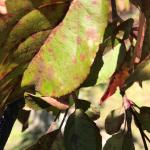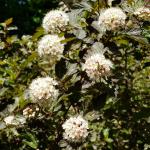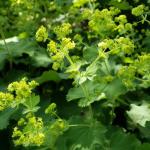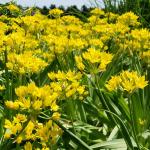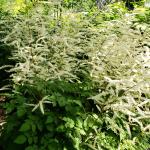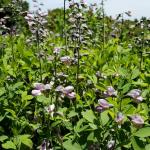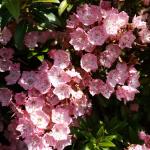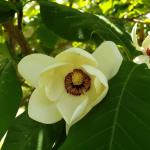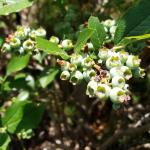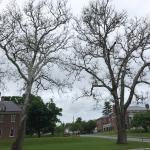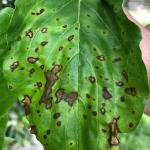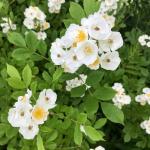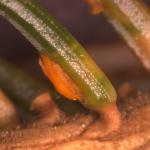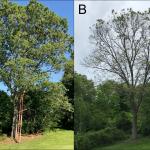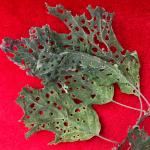UMass Extension's Landscape Message is an educational newsletter intended to inform and guide Massachusetts Green Industry professionals in the management of our collective landscape. Detailed reports from scouts and Extension specialists on growing conditions, pest activity, and cultural practices for the management of woody ornamentals, trees, and turf are regular features. The following issue has been updated to provide timely management information and the latest regional news and environmental data.
To read individual sections of the message, click on the section headings below to expand the content:
Scouting Information by Region
Environmental Data
The following data was collected on or about June 12, 2019. Total accumulated growing degree days (GDD) represent the heating units above a 50° F baseline temperature collected via our instruments for the 2019 calendar year. This information is intended for use as a guide for monitoring the developmental stages of pests in your location and planning management strategies accordingly.
|
MA Region/Location |
GDD |
Soil Temp |
Precipitation |
Time/Date of Readings |
||
|
1-Week Gain |
2019 Total |
Sun |
Shade |
|||
|
CAPE |
96 |
349 |
65 |
60 |
1.24 |
12:00 PM 6/12 |
|
SOUTHEAST |
99.5 |
419 |
62 |
56 |
1.35 |
6:45 PM 6/11 |
|
NORTH SHORE |
100.5 |
418 |
62 |
57 |
1.09 |
9:30 AM 6/12 |
|
EAST |
118 |
479 |
66 |
61 |
0.87 |
6:00 PM 6/11 |
|
METRO |
114 |
440.5 |
63 |
58 |
1.34 |
5:30 AM 6/12 |
|
CENTRAL |
116 |
476.5 |
65 |
49 |
0.65 |
4:10 PM 6/12 |
|
PIONEER VALLEY |
115 |
490 |
70 |
63 |
0.86 |
11:00 AM 6/12 |
|
BERKSHIRES |
72 |
421 |
63 |
57 |
1.06 |
8:30 AM 6/12 |
|
AVERAGE |
107 |
437 |
65 |
58 |
1.06 |
- |
n/a = information not available
Phenology
| Indicator Plants - Stages of Flowering (BEGIN, BEGIN/FULL, FULL, FULL/END, END) | ||||||||
|---|---|---|---|---|---|---|---|---|
| PLANT NAME (Botanic/ Common) | CAPE | S.E. | N.S. | EAST | METRO W. | CENT. | P.V. | BERK. |
|
Cotinus coggygria (common smokebush) |
* |
* |
* |
* |
Begin |
* |
* |
* |
|
Hydrangea anomala petiolaris (climbing Hydrangea) |
Begin |
Full |
Begin/Full |
Begin/Full |
Begin/Full |
Begin/Full |
Begin/Full |
Begin |
|
Kalmia latifolia (mountain laurel) |
Begin |
Begin/Full |
Begin/Full |
Begin |
Begin |
Begin |
Full |
* |
|
Philadelphus spp. (mockorange) |
Begin/Full |
Full |
Full |
Full |
Full |
Full |
Begin |
Begin |
|
Chionanthus virginicus (fringe tree) |
Begin/Full |
Full |
Full |
Full |
Full |
Full |
Full |
Full |
|
Cornus kousa (kousa dogwood) |
Begin/Full |
Full |
Full |
Full |
Full |
Full |
Full |
Full |
|
Kolkwitzia amabilis (beautybush) |
Full |
Full |
Full |
Full |
Full |
Full |
Full/End |
Full |
|
Weigela florida (old fashioned Weigela) |
Full |
Full |
Full |
Full |
Full |
Full |
End |
Full |
|
Deutzia spp. (Deutzia species) |
Full |
Full |
Full/End |
Full |
* |
Full |
Full/End |
Full |
|
Enkianthus campanulatus (redvein Enkianthus) |
* |
Full/End |
Full/End |
Full/End |
Full/End |
Full/End |
End |
Full |
| * = no activity to report/information not available | ||||||||
Regional Notes
Cape Cod Region (Barnstable)
General Conditions: The average temperature over the period from June 5 – June 12 was a comfortable 63˚F with a high of 77˚F on June 6 and a low of 46˚F on June 9. Two precipitation events, June 6 and June 11, occurred during the period providing over an inch of rain. The precipitation was needed as some unirrigated lawns on coarse soils were starting to show signs of water stress. Topsoil moisture and subsoil moisture is adequate.
Pests/Problems: Lecanium scale female adults continue to lay eggs. Lecanium scale adults (4-9mm hemispherical humps) can be found concentrated on twig growth of oak, sweet gum, and black gum. Some white oak with high populations are showing twig dieback. Other insects or damage seen over the period include Eastern tent caterpillar damage to black cherry, sawfly larvae feeding on oak, rose slug sawfly on rose, Viburnum leaf beetle larvae on Viburnum, lily leaf beetle on lily, four-lined plant bug damage on shasta daisy. Disease symptoms and signs seen over the period include anthracnose on sycamore, anthracnose on maple, spot anthracnose on dogwood, black spot on rose, red thread on turf, azalea leaf and flower gall on azalea, and slug damage on Hosta. Ticks, bunnies, wood chucks, and mosquitoes abound. Weeds in bloom include black medic (Medicago lupulina), cypress spurge (Euphorbia cyparissias), white clover (Trifolium repens), hawkweed (Hieracium pratense) and multiflora rose (Rosa multiflora).
Southeast Region (New Bedford)
There are no regional notes this week.
Attention Southeast region readers: Would you be a good scout for the Landscape Message? UMass Extension is seeking a capable individual to take over reporting duties for the Southeast region starting ASAP. Candidates must be able to scout and report weekly through June, bi-weekly through July, August, and September, and monthly in October, November, and December. Ideally this person would be located in roughly the Brockton-Bridgewater-Taunton area (or able to regularly scout that area), although we will entertain inquiries from throughout Bristol and Plymouth Counties. The scouting and reporting for each message is estimated to take approximately 1/2 day per message week, and UMass Extension is able to pay a stipend for scouts. If interested, see the "Description of Responsibilities" here: https://ag.umass.edu/sites/ag.umass.edu/files/content-files/alerts-messages/2018_scout_expectations.pdf then contact Ellen Weeks at weeks@umass.edu or 413-545-2685 to apply.
North Shore (Beverly)
General Conditions: This reporting period we experienced very pleasant late spring weather. Most days were nice with mostly sunny or partially sunny skies except for June 6 and 11 when we had rain showers. Day temperatures were in the low to mid 70s and the night temperatures were in the low to mid 50s. Approximately 1.09 inches of rainfall were recorded at Long Hill during this period. Woody plants seen in bloom include: Chinese dogwood (Cornus kousa), Arrowwood Viburnum (Viburnum dentatum), Chinese Neillia (Neillia sinensis), fringe tree (Chionanthus virginicus), mock orange (Philadelphus spp.), beautybush (Kolkwitzia amabilis), mountain laurel (Kalmia latifolia), Weigela (Weigela florida), mapleleaf Viburnum (Viburnum acerifolium), tulip tree (Liriodendron tulipifera), fragrant snowbell (Styrax obassia), and Chinese fringetree (Chionanthus retusus). Non-woody plants seen in bloom include: bush cinquefoil (Potentilla fruticosa), foam flower (Tiarella cordifolia), fetterbush (Leucothoe fontanesiana), Scotch rose (Rosa spinosissima), peony (Paeonia spp.), cranesbill (Geranium spp.), bleeding heart (Dicentra spectabilis), redleaf rose (Rosa glauca), Rodger's flower (Rodgersia aesculifolia), goat’s beard (Aruncus dioicus), Japanese primrose (Primula japonica), columbine (Aquilegia spp.), sweet woodruff (Galium odoratum), and a plethora of annuals.
Pests/Problems: Apple scab, observed on crabapples, is caused by the fungus Venturia inaequalis. It is common on susceptible apples and crabapples. It produces lesions that are most usually seen on leaves, causing those leaves to yellow and drop prematurely. Removing fallen leaves can help minimize the disease. Deer browsing damage was observed on Hosta. American cranberry Viburnum leaves have been completely skeletonized by Viburnum leaf beetle larvae. High pH iron deficiency interveinal chlorosis (yellowing between veins) was observed on blueberries and azaleas. You can correct iron deficiency by lowering the pH by using acidic fertilizer (ammonium sulphate) or applying elemental sulfur. Multiflora rose (Rosa multiflora) and wild raspberry (Rubus rosifolius) weeds are in full bloom and are easy to identify. Mosquitoes and ticks are still very active so protect yourself with insect repellent when working outdoors, especially at dawn and at dusk.
East Region (Boston)
General Conditions: It was a good week weather-wise. Temperatures averaged 79˚F, ranging from 75-84.5˚F. Lows averaged 57.5˚F, ranging from 51-64˚F. We received 0.87” of precipitation over the past seven days for a total of 0.92” in June. We have reached 479 GDDs. There is an abundance of color throughout the landscape. Some noteworthy plants in bloom include: Calycanthus floridus (sweetshrub), Clematis recta ‘Purpurea’, Eschscholzia californica (golden poppy), Indigofera kirilowii (Chinese indigo), Kolkwitzia amabilis (beautybush), Lysimachia punctata (yellow loosestrife), Philadelphus spp. (mockorange), Rosa spp. cultivars, Syringa reticulata (Japanese tree lilac), Tripterygium wilfordii (thunder god vine) and Wisteria frutescens (Wisteria). The distinct, variegated, white flush of leaves on Salix integra ‘Hakuro Nishiki’ is putting on quite a show!
Pests/Problems: The rose sawfly (Endelomia aethiops) larvae have been active skeletonizing rose foliage, resulting in brown papery silhouettes of the leaves. Dusky birch sawfly larvae were observed feeding on foliage of recently planted Betula nigra ‘BNMTF’ Dura-Heat®. Fletcher scale (Parthenolecanium fletcheri) is active on Taxus spp. - the vulnerable crawlers were observed laying eggs. The presence of Taphrina deformans, the fungus causing peach leaf curl, is evidenced by the resulting deformed leaves. Multiflora rose (Rosa multiflora) is in full bloom along woodland edges and abandoned farm fields.
Metro West (Acton)
General Conditions: The gorgeous late spring-early summer-like weather continued into this week’s reporting period. High temperatures were recorded in the 80’s all week with the exception of a high temperature of 77° recorded on the 11th. Rain has been intermittent and so far I have recorded 1.68” for June. Traditionally, the June average monthly rainfall is 3.93”. Much is in bloom at this time of the year, including the following woody plants: Buddleia spp. (butterfly-bush), Chionanthus retusus (Chinese fringe tree), C. virginicus (fringe tree), Cornus florida (dogwood), C. x rutgersensis 'Ruth Ellen' (Rutgers hybrid dogwood), Cornus sericea (red twig dogwood), Cotinus coggygria (common smokebush), Crataegus spp. (hawthorn), Kerria japonica (Japanese Kerria), K. japonica ‘Pleniflora’ (double flowered Japanese Kerria), Kolkwitzia amabilis (beautybush), Laburnum x watereri (golden chain tree), Leucothoe axillaris (coast leucothoe), Ligustrum spp. (privet), Liriodendron tulipifera (tulip tree), Philadelphus coronarius (sweet mock orange), Physocarpus opulifolius (common ninebark), P. opulifolius 'Summer Wine' (summer wine ninebark), Potentilla fruiticosa (Potentilla), Robinia pseudoacacia (black locust), Rhododendron spp. (Rhododendron/azalea), Rosa spp. (rose), R. rugosa (rose), R. 'Knockout' (knockout family of roses), Rubus spp. (blackberry, bramble, raspberry), Spiraea spp. (bridal wreath), Syringa reticulata (Japanese tree lilac), S. spp. (late blooming lilac), Viburnum dentatum (arrowwood Viburnum), V. sargentii (Sargent Viburnum) and Weigela florida (old fashioned Weigela). Woody vines in bloom are: Clematis spp. (Clematis), Lonicera sempirvirens (trumpet honeysuckle), and Wisteria spp. (Wisteria).
Contributing even more color and interest to the landscape are some flowering herbaceous plants and spring ephemerals including: Ajuga reptans (bugleweed), Alchemilla mollis (lady’s mantle), Allium spp. - ornamental flowering onion, including A. giganteum (giant onion)and A. schoenoprasum (chives), Amsonia hubrichtii (Arkansas blue star), Aquilegia vulgaris (columbine), Aruncus dioicus (goat’s beard), Aurinia saxatilis (basket of gold), Baptisia australis (false blue indigo), Chrysogonum virginianum (green and gold), Coreopsis spp. (tickseed), Dianthus deltoides (maiden pink), Dicentra eximia (fringed bleeding heart), Dictamnus albus (gas plant), Digitalis purpurea (foxglove), Geranium cantabrigiense 'Biokovo' and 'Cambridge' (hardy cranesbill), Geranium maculatum (wild Geranium), G. macrorrhizum (bigroot Geranium), G. sanguineum (bloody cranesbill), Gillenia trifoliata (bowman’s root), Hemerocallis 'Stella D'Oro' (daylily), Hemerocallis spp. (early flowering daylily), Heuchera spp.(coral bells), Hyacinthoides hispanica (wood hyacinth), Iris germanica (bearded Iris), I. sibirica (Siberian Iris), I. versicolor (blue flag iris), Lupinus' 'Russell Woodfield Hybrids' (lupine), Nepeta spp. (ornamental catmint), Paeonia spp. (peony), Papaver orientale (oriental poppy), Phlox divaricata (Canadian Phlox), Primula spp. (primrose), Salvia nemerosa (Salvia), Saponaria ocymoides (rock soapwort), Tradescantia spp. (spiderwort) Thymus praecox (thyme), Veronica umbrosa ‘Georgia Blue’ (speedwell), Vinca minor (periwinkle), and Viola spp. (violet).
Pests/Problems: Rosa multiflora, an aggressive and invasive vine, is just coming into bloom and is very easy to detect with its abundant white flowers and is seen growing in and amongst other trees and shrubs in the planted and/or wild landscape. Fall webworm is feeding heavily and has completely defoliated young elm saplings. Ticks and mosquitoes are feeding and active.
Central Region (Boylston)
General Conditions: This was a wonderful weather week. Night-time temperatures were consistently in the 50’s, touching the mid- to high-40’s, making for great sleeping weather. Consistent day-time temperatures in the high 70’s and low 80’s made for great gardening weather. Late spring and early summer flowers are abundant in the garden right now. Several species of Geranium, including our native wild Geranium, Geranium maculatum, are in full bloom. Pink lady’s-slippers, Cypripedium acaule are finishing up, but yellow lady’s-slippers, Cypripedium parviflorum are just beginning. Physocarpus opulifolius, common ninebark is in full bloom. Ninebarks with purple foliage, including the cultivars ‘Diablo’ and ‘Mindia’ (aka Coppertina®) are great alternatives to the invasive Japanese barberry, Berberis thunbergii.
Pests/Problems: Gypsy moth continue to feed on susceptible trees. Slugs, ticks, and especially mosquitoes are abundant in the garden.
Pioneer Valley Region (Amherst)
General Conditions: We experienced a beautiful stretch of full sun and warm weather in the Pioneer Valley over this past reporting period. High temperatures mostly hovered in the lower to middle 80s, but a lack of humidity and cool nights in the 50s made for some fantastic early summer weather. Rising humidity developed on Monday, 6/10 as a large storm system brought widespread, overnight rain showers. Accumulations ranged from 0.7ʺ to 1ʺ at many weather stations in valley. This was the first significant rain event in June for Hampshire and Hampden Counties, ending a roughly two-week stretch of dry conditions. Franklin County, in contrast, has been the recipient of regular rainfall in early June; storms that consistently skirted the southern half of the valley. As the storm cleared out on 6/11, strong winds developed with gusts up to 35 mph recorded at Barnes Airport in Westfield. The warm weather sent soil temperatures rocketing up to the 70°F threshold in the full sun monitoring location at UMass. The shaded soil reading remains much cooler in the lower 60s. Clover is rich and in full bloom right now but crabgrass continues to develop in untreated lawns. Turf grass growth had slowed dramatically in early June but the recent rain should boost growth again. With mosquito season in full swing, check properties for standing water in pots, buckets, etc. that could serve as breeding sites, especially underneath decks where these items may be hidden from view.
Pests/Problems: An infestation by the oak shothole leafminer (Japanagromyza viridula) and subsequent infection by the oak anthracnose pathogen (Apiognomonia errabunda) is locally abundant in the Pioneer Valley this season. See the Pest Alert on this pest-pathogen outbreak below the regional reports. Oaks damaged by the shothole leafminer and anthracnose may have thin canopies and fine twig dieback. Trees with severe infestations of the leafminer may have leafed out late this season. Among the many oaks observed in Hampshire County, the damage appears minor and this outbreak will not likely have a major impact on health this season. It appears that all oak species common in the region (red, black, pin, white and swamp white) are impacted. Sycamore anthracnose continues to delay leaf out for some large and significant sycamores in the area. The trees pictured below were photographed on 6/11 in Amherst and have very few leaves present. However, a large sycamore on the UMass campus is developing new and healthy leaves, illustrating the variation in disease severity across the area. Premature needle shedding for eastern white pine is abundant right now on the UMass campus and elsewhere. Needle shedding doesn’t appear to be as severe as in previous years, possibly due to the relatively dry conditions we experienced in June of 2018. Wet weather, primarily during the month of June when new needles are elongating, facilitates the infections we see the following year. Foliar symptoms of dogwood anthracnose are clearly visible at this time (photo below). Apple scab (pictured below) and possibly Marssonina leaf blotch are abundant on landscape crabapples and apples at this time. Trees regularly monitored on the UMass campus are starting to shed interior canopy leaves. Woolly apple aphid was observed on American elms. Infested leaves cluster into rosettes and have large, conspicuous masses of woolly aphids present. Prune and discard the rosettes as they are found. Multiflora rose is in full flower right now (see photo). While certainly not as widespread and destructive as Oriental bittersweet, multiflora rose can climb and suffocate landscape trees if left to its own devices. Speaking of the bittersweet, continue to weed seedlings in ornamental beds and woodland edges before they become mature, firmly-rooted vines.
Berkshire Region (Great Barrington)
General Conditions: Finally, we had some persistent sun and warmth during the past week. Temperatures reached into the low 80s on June 8 and 9. With 1.06 inches of rain for the week, soils remain moist and are in ideal condition for planting woody and herbaceous plants, i.e. post plant watering not needed except on the most sandy or gravelly sites. Most nights have been a bit cooler than normal, allowing the bloom period of lilacs, Rhododendrons, and early bloomers to be extended. Turfgrass growth has been vigorous as has weed development in lawns and gardens. Overall, conditions have been favorable for planting and plant development. Sales of plants at retail nurseries and garden centers have also been vigorous.
Pests/Problems: Pupal cases of boxwood leaf miners can be seen draped on the underside of leaves of boxwood. The cases are empty indicating that the adult gnat-like flies have emerged and have been laying eggs in the new foliage growth. Shaking the branches of boxwood plants will stir up the adult flies. If flies are not seen, it usually means that egg laying has been completed. One means of control of boxwood leaf miner is to shear back the new growth which contains the newly laid eggs for the next generation. Clippings must be collected and destroyed. Winged tuliptree aphids and nymphs were observed on the underside of leaves of tulip trees (Liriodendron tulipifera). These aphids feed on the undersides of leaves, causing the leaves to turn yellow initially, then brown and drop. The bigger issue with these and other aphids may be the honeydew which they excrete. Besides dripping down onto the ground and anything beneath the tree, the honeydew makes a medium for growth of sooty mold. Other pests observed this week included lily leaf beetle (larvae), imported willow leaf beetle (larvae), Viburnum leaf beetle (larvae), and spruce spider mite.
Perhaps the most staggering problem this spring has been the extensive amount of winter related damage to trees and shrubs. Many woody plants have experienced significant death to branches. Besides evergreens, i.e. boxwood, Rhododendrons, and junipers, many deciduous plants have also shown much dieback and even death of entire plants. Deutzias seem to have been hit particularly hard. Some affected plants are starting to send out shoots from their base but others show no life or signs of growth. The abrupt changes in temperature through this past winter are likely to be a factor. Back on January 21, daytime temperatures in much of the County did not get above zero and the nighttime temperature dropped to as low as -18˚F. Three days later, temperatures rose to the mid-50s, followed less than a week later by temperatures again well below zero. Similar events were repeated in February. Another factor may have been the long stretch of saturated soils back in October and November which could have caused damage to plant roots due to lack of oxygen in the water-logged soil.
Regional Scouting Credits
- CAPE COD REGION - Russell Norton, Horticulture and Agriculture Educator with Cape Cod Cooperative Extension, reporting from Barnstable.
- SOUTHEAST REGION - Kristin McCullin, Horticulturist reporting from Haskell Public Gardens, New Bedford.
- NORTH SHORE REGION - Geoffrey Njue, Green Industry Specialist, UMass Extension, reporting from the Long Hill Reservation, Beverly.
- EAST REGION - Kit Ganshaw & Sue Pfeiffer, Horticulturists reporting from the Boston area.
- METRO WEST REGION – Julie Coop, Forester, Massachusetts Department of Conservation & Recreation, reporting from Acton.
- CENTRAL REGION - Mark Richardson, Director of Horticulture reporting from Tower Hill Botanic Garden, Boylston.
- PIONEER VALLEY REGION - Nick Brazee, Plant Pathologist, UMass Extension Plant Diagnostic Lab, reporting from UMass Amherst.
- BERKSHIRE REGION - Ron Kujawski, Horticultural Consultant, reporting from Great Barrington.
Woody Ornamentals
Recent pests and pathogens of interest seen in the UMass Extension Plant Diagnostic Lab https://ag.umass.edu/services/plant-diagnostics-laboratory:
Diseases
Infestation by the oak shothole leafminer (Japanagromyza viridula) and subsequent infection by the oak anthracnose pathogen (Apiognomonia errabunda). See the Pest Alert at the beginning of the Insect section below on this pest-pathogen outbreak.
Needle cast of eastern white pine (Pinus strobus) caused by Septorioides strobi and Bifusella linearis. The tree is approximately 35- to 40-years-old and resides in a full sun landscape setting. Yellowing and browning of needles have been observed in the canopy but the managing arborist does not have a history with the tree from years past. Four fungal pathogens are primarily associated with white pine needle damage in the northeast. Early to mid-June is often the peak period of premature needle shedding, fungal spore production and infection of newly developing needles. Elongating needles infected now will become symptomatic in 2020.
Brown rot, caused by Monilinia fructicola, on weeping Higan cherry (Prunus subhirtella ʹPendulaʹ). The tree is ten-years-old and has been present at the site for four years. The tree resides in full sun with supplemental watering provided. This spring, leaf browning and shoot tip dieback was observed in scattered areas of the canopy. However, the damage remains relatively minor at this time. Brown rot has been particularly abundant on Prunus this spring, likely due to the abundant rainfall in late summer and autumn of 2018.
Winter injury, Rhizosphaera needle cast and spruce needle rust (Chrysomyxa weirii; pictured below) of Serbian spruce (Picea omorika). The tree is 20-years-old and has been present at the site for 15 years. In 2017, needle yellowing and browning developed in the lower canopy of the tree. The site offers full sun but has wet and heavy soils. Serbian spruce can tolerate a range of soil pH conditions and prefers moist soils that drain well. This species appears more prone to winter injury compared to other landscape spruces. The needles of Serbian spruce better resemble those of true fir, with rounded tips and stomata occurring only on the underside (abaxial surface).
Report by Nick Brazee, Plant Pathologist, UMass Extension Plant Diagnostic Lab, UMass Amherst.
Insects
Pest Alert: Leaf Damage to Oaks Caused by the Oak Shothole Leafminer and Oak Anthracnose
Summary: A dramatic and possibly widespread outbreak of the oak shothole leafminer (Japanagromyza viridula synonym Agromyza viridula) and oak anthracnose (Apiognomonia errabunda) has occurred this season. To date, samples and observations of the outbreak have been made in western and eastern Massachusetts, coastal Rhode Island, southern New Hampshire, eastern New York and eastern Pennsylvania. The oak shothole leafminer is a small fly in the family Agromyzidae. Not much is known about this particular species, although very short-lived outbreaks of this insect on ornamental oaks have been recorded in New England in the past. The oak anthracnose pathogen appears to be readily colonizing foliage damaged by the leafminer. The anthracnose damage appears mostly minor to moderate in severity (leaf spots and blotches). However, for some trees the disease has been far more damaging (leaf wilting, death and premature shedding). Infected leaves may have tan to brown-colored spots and blotches or appear blackened and wilted.
For more information, go to: http://ag.umass.edu/landscape/news/leaf-damage-to-oaks-caused-by-oak-shothole-leafminer-oak-anthracnose
Woody ornamental (and other) insect and non-insect arthropod pests to consider, a selected few:
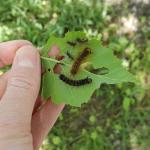
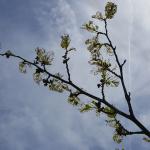
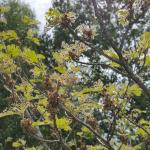 Gypsy Moth:(Lymantria dispar) host plants include but are certainly not limited to oak (favored), maple, birch, poplar, elm, witch hazel, and many others. At a location in Boylston, MA, higher densities of gypsy moth caterpillars were observed feeding on river birch, witch hazel, and willow on 6/12/19 than have been observed and previously reported at a location being monitored in Amherst, MA. At this particular location in Boylston, it was easy to find at least one caterpillar per leaf observed on the aforementioned host plants. (Whereas in Amherst, densities remain closer to one caterpillar per 50 or more leaves.) Witch hazel, in particular, was being eaten down to the leaf veins by caterpillars in this location.
Gypsy Moth:(Lymantria dispar) host plants include but are certainly not limited to oak (favored), maple, birch, poplar, elm, witch hazel, and many others. At a location in Boylston, MA, higher densities of gypsy moth caterpillars were observed feeding on river birch, witch hazel, and willow on 6/12/19 than have been observed and previously reported at a location being monitored in Amherst, MA. At this particular location in Boylston, it was easy to find at least one caterpillar per leaf observed on the aforementioned host plants. (Whereas in Amherst, densities remain closer to one caterpillar per 50 or more leaves.) Witch hazel, in particular, was being eaten down to the leaf veins by caterpillars in this location.
Anecdotally, at this time, gypsy moth caterpillar densities on host plant leaves in certain areas, such as parts of Amherst, are lower than what was expected given the number of overwintering egg masses. However, certain locations (such as the above observation in Boylston) in Massachusetts may have locally dense populations of caterpillars this year. While we have had reports of caterpillar activity and feeding across the state, we suspect that an early mortality event (that cannot yet be explained) may have occurred. Dr. Joseph Elkinton and his lab are working with collaborators to see if they can determine what caused this early season mortality. Dr. Elkinton also reports that areas of Amherst are much different this year from what was observed last season (despite some areas having had large numbers of overwintering egg masses). He describes being able to spot at least one caterpillar per leaf on oak in Amherst last year, whereas this season “you really have to hunt for them” in the same locations. While this is certainly excellent news, we should remain cautiously optimistic and continue to monitor gypsy moth populations and feeding damage, particularly in the areas mentioned below in the 2018 overwintering egg mass survey conducted by MA DCR.
Despite the fungal outbreak that swept through the 2017 caterpillar population, some lucky caterpillars survived to pupation and emerged as adult moths. (However, adults were present in 2017 in far fewer numbers than would have existed without the fungus.) In 2018, the Massachusetts Department of Conservation and Recreation (DCR) reported that approximately 159,705 acres were defoliated by gypsy moth caterpillars in pockets across the state. While this may seem negligible in comparison to the 923,186 acres of defoliation due to gypsy moth in 2017, for many communities the impact was still significant. MA DCR also surveyed multiple locations across the state for overwintering gypsy moth egg masses in December of 2018. They provide a map of their predictions of where pockets of defoliation may occur in 2019 based on the densities of egg masses they observed in monitored areas across the state. Many of these areas correspond with the locations previously defoliated by gypsy moth caterpillars in 2018. MA DCR predicts gypsy moth activity will occur this season in regionalized pockets of Essex, Hampden, Hampshire, Middlesex, Norfolk, Plymouth, and Worcester Counties. Maps of previous year’s defoliation as well as the 2018 overwintering gypsy moth egg mass survey may be found courtesy of the MA DCR here: https://www.mass.gov/guides/gypsy-moth-in-massachusetts .
While it is very difficult to predict how much defoliation Massachusetts will see in 2019 due to gypsy moth caterpillar feeding, it is possible that in areas where many egg masses overwintered, pockets of defoliation could still occur in certain areas of the state this year.
- Asian Longhorned Beetle: (Anoplophora glabripennis, ALB) Look for signs of an ALB infestation which include perfectly round exit holes (about the size of a dime), shallow oval or round scars in the bark where a female has chewed an egg site, or sawdust-like frass (excrement) on the ground nearby host trees or caught in between branches. Be advised that other, native insects may create perfectly round exit holes or sawdust-like frass, which can be confused with signs of ALB activity.
The regulated area for Asian longhorned beetle is 110 miles2 encompassing Worcester, Shrewsbury, Boylston, West Boylston, and parts of Holden and Auburn. If you believe you have seen damage caused by this insect, such as exit holes or egg sites, on susceptible host trees like maple, please call the Asian Longhorned Beetle Eradication Program office in Worcester, MA at 508-852-8090 or toll free at 1-866-702-9938.
To report an Asian longhorned beetle find online or compare it to common insect look-alikes, visit: http://massnrc.org/pests/albreport.aspx or https://www.aphis.usda.gov/pests-diseases/alb/report .
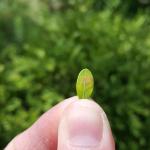
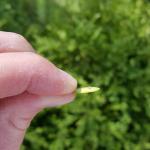
 Boxwood Psyllid: Cacopsylla buxi produces cupping of the leaves of American boxwood. Nymphs, covered in long threads of wax, feed on newly developing leaves in the spring. As the cupped leaves form, nymphs are protected from horticultural oil and insecticidal soap applications. Nymphs use these sheltered areas to continue feeding until late May and early June. One generation occurs per year. Adults lay the overwintering eggs near bud scales in the early summer. Damage from previous feeding by the boxwood psyllid was observed on 6/12/19 in Boylston, MA. Cupped leaves could be found on Buxus spp. ‘Green Gem’, but the extent of the distorted leaves on the plants was minimal. Most Buxus sempervirens cultivars are preferred and thus damaged, whereas English boxwoods rarely are damaged by the psyllid. However, the injury caused by this insect is primarily aesthetic. It is not typically as damaging as injury caused by the boxwood leafminer (Monarthropalpus flavus), the adult flies of which typically emerge in late May to early June between roughly 300-650 GDD’s. Eggs are laid in the upper side of the current season’s leaves and hatch in roughly 3 weeks. Larvae feed within the leaves, which may become yellow and spotted and drop prematurely. Over multiple seasons, twig dieback may occur. Partially grown larvae overwinter. This insect attacks most cultivars of Buxus sempervirens and B. microphylla. Buxus sempervirens ‘Vardar Valley’ is considered to be resistant to the boxwood leafminer. Mined leaves from the boxwood leafminer were observed on 6/12/19 in Boylston, MA. Leaf mines could be found on Buxus spp. ‘Green Gem’, along with shed pupal “skins” stuck to the leaves, indicating that the adult fly had emerged.
Boxwood Psyllid: Cacopsylla buxi produces cupping of the leaves of American boxwood. Nymphs, covered in long threads of wax, feed on newly developing leaves in the spring. As the cupped leaves form, nymphs are protected from horticultural oil and insecticidal soap applications. Nymphs use these sheltered areas to continue feeding until late May and early June. One generation occurs per year. Adults lay the overwintering eggs near bud scales in the early summer. Damage from previous feeding by the boxwood psyllid was observed on 6/12/19 in Boylston, MA. Cupped leaves could be found on Buxus spp. ‘Green Gem’, but the extent of the distorted leaves on the plants was minimal. Most Buxus sempervirens cultivars are preferred and thus damaged, whereas English boxwoods rarely are damaged by the psyllid. However, the injury caused by this insect is primarily aesthetic. It is not typically as damaging as injury caused by the boxwood leafminer (Monarthropalpus flavus), the adult flies of which typically emerge in late May to early June between roughly 300-650 GDD’s. Eggs are laid in the upper side of the current season’s leaves and hatch in roughly 3 weeks. Larvae feed within the leaves, which may become yellow and spotted and drop prematurely. Over multiple seasons, twig dieback may occur. Partially grown larvae overwinter. This insect attacks most cultivars of Buxus sempervirens and B. microphylla. Buxus sempervirens ‘Vardar Valley’ is considered to be resistant to the boxwood leafminer. Mined leaves from the boxwood leafminer were observed on 6/12/19 in Boylston, MA. Leaf mines could be found on Buxus spp. ‘Green Gem’, along with shed pupal “skins” stuck to the leaves, indicating that the adult fly had emerged.- Deer Tick/Blacklegged Tick: Check out the archived FREE TickTalk with TickReport webinars available here:https://ag.umass.edu/landscape/education-events/webinars . The next live webinar will be held on October 9, 2019 with Dr. Stephen Rich of the UMass Laboratory of Medical Zoology. Previous webinars including information about deer ticks and associated diseases, American dog ticks and lone star ticks and associated diseases, ticks and personal protection, and updates from the Laboratory of Medical Zoology are archived at the link above.
Deer tick (Ixodes scapularis) nymphs (immatures) are active at this time, and may be encountered now through August. For images of all deer tick life stages, along with an outline of the diseases they carry, visit: http://www.tickencounter.org/tick_identification/deer_tick .
Anyone working in the yard and garden should be aware that there is the potential to encounter deer ticks. The deer tick or blacklegged tick can transmit Lyme disease, human babesiosis, human anaplasmosis, and other diseases. Preventative activities, such as daily tick checks, wearing appropriate clothing, and permethrin treatments for clothing (according to label instructions) can aid in reducing the risk that a tick will become attached to your body. If a tick cannot attach and feed, it will not transmit disease. For more information about personal protective measures, visit: http://www.tickencounter.org/prevention/protect_yourself .
Have you just removed an attached tick from yourself or a loved one with a pair of tweezers? If so, consider sending the tick to the UMass Laboratory of Medical Zoology to be tested for disease causing pathogens. To submit a tick to be tested, visit: https://www.tickreport.com/ and click on the blue “Order a TickReport” button. Results are typically available within 3 business days, or less. By the time you make an appointment with your physician following the tick attachment, you may have the results back from TickReport to bring to your physician to aid in a conversation about risk.
The UMass Laboratory of Medical Zoology does not give medical advice, nor are the results of their tests diagnostic of human disease. Transmission of a pathogen from the tick to you is dependent upon how long the tick had been feeding, and each pathogen has its own transmission time. TickReport is an excellent measure of exposure risk for the tick (or ticks) that you send in to be tested. Feel free to print out and share your TickReport with your healthcare provider.
- Eastern Tent Caterpillar: Malacosoma americanum caterpillars will finish their feeding and tent construction this month. Adult moths typically appear by the end of June to early July. Susceptible hosts include cherry and crabapple. Other host plants whose leaves are fed upon by this insect can include apple, ash, birch, willow, maple, oak, poplar, and witch-hazel. Eastern tent caterpillars are native to Massachusetts and have many associated natural enemies (parasites and predators) that help regulate populations. Unless these caterpillars are actively defoliating specimen trees in a landscaped setting, we can coexist with this particular herbivore native to our forests.
- Elongate Hemlock Scale: Fiorinia externa is found on eastern, Carolina, and Japanese hemlock, as well as yew, spruce, and fir. Overlap of many developmental stages at any given time can be observed. Treatments for the crawler, or mobile, stage of this insect may be made in late May through mid-June, or between 360-700 GDD’s, base 50°F.
- Emerald Ash Borer: (Agrilus planipennis, EAB) Thus far in 2019, the Massachusetts Department of Conservation and Recreation has confirmed 26 new community detections of emerald ash borer in Massachusetts. While the cities and towns with recent detections of EAB are too numerous to list here, they are in areas of Berkshire, Hampden, Hampshire, Middlesex, and Worcester counties. A map of these locations and others previously known across the state may be found here: https://ag.umass.edu/fact-sheets/emerald-ash-borer .
This wood-boring beetle readily attacks ash (Fraxinus spp.) including white, green, and black ash and has also been found developing in white fringe tree (Chionanthus virginicus) and has been reported in cultivated olive (Olea europaea). Adult insects of this species will not be present at this time of year. Signs of an EAB infested tree may include (at this time) D-shaped exit holes in the bark (from adult emergence in previous years), “blonding” or lighter coloration of the ash bark from woodpecker feeding (chipping away of the bark as they search for larvae beneath), and serpentine galleries visible through splits in the bark, from larval feeding beneath. Positive identification of an EAB-infested tree may not be possible with these signs individually on their own.
For further information about this insect, please visit: https://ag.umass.edu/fact-sheets/emerald-ash-borer . If you believe you have located EAB-infested ash trees, particularly in an area of Massachusetts not identified on the map provided, please report here: http://massnrc.org/pests/pestreports.htm .

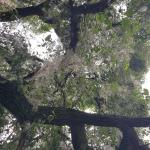 Euonymus Caterpillar: Yponomeuta cagnagella is of European origin and widespread in distribution throughout Europe. It was first reported in North America in Ontario in 1967. Euonymus caterpillars have begun to pupate at a location being observed in Amherst, MA as of 6/11/19. The white, elongated and oval-shaped cocoons created by caterpillars ready to pupate can be found within webs on branches and leaves, in the grass beneath infested host plants, and sheltered areas nearby. Because this does not happen all at once, some caterpillars can still be observed feeding at this location.
Euonymus Caterpillar: Yponomeuta cagnagella is of European origin and widespread in distribution throughout Europe. It was first reported in North America in Ontario in 1967. Euonymus caterpillars have begun to pupate at a location being observed in Amherst, MA as of 6/11/19. The white, elongated and oval-shaped cocoons created by caterpillars ready to pupate can be found within webs on branches and leaves, in the grass beneath infested host plants, and sheltered areas nearby. Because this does not happen all at once, some caterpillars can still be observed feeding at this location.
The euonymus caterpillars (larvae) feed in groups and envelop the foliage of the host plant in webs as they feed. Hosts include: Euonymus europaeus (tree form), E. kiautschovicus, E. alatus, and E. japonicus. Mature caterpillars are just under an inch in length, creamy yellow-gray in color with black spots and a black head capsule. By late June, these larvae pupate in white, oval-shaped cocoons which are typically oriented together vertically either on host plants or non-hosts in the area. Cocoons can be found in cracks and crevices, or webbed together leaves. The adult moth emerges in late June in most locations. The adult female secretes a gummy substance over her eggs which will harden, making them even more difficult to see. Eggs hatch by mid-August, at which time the tiny larvae prepare to overwinter beneath their eggshell-like covering. These larvae are inactive until the following year, when caterpillars group together to feed on newly emerging leaves, creating a mess of webs as they feed. There is one generation per year. Plants may be partially or entirely defoliated. Management of young, actively feeding caterpillars with Bacillus thuringiensis is possible if deemed necessary, however many species of Euonymus are considered invasive themselves.
- Forest Tent Caterpillar: Malacosoma disstria caterpillars were observed wandering in the same locations as gypsy moth caterpillars in Boylston, MA on 6/12/19. Forest tent caterpillars are hairy, with black and blue coloration in addition to white, “key-hole” shaped markings along the dorsal side of the caterpillar. (Some also describe these markings as looking like little penguins.) Susceptible hosts whose leaves are fed on by this insect include oak, birch, ash, maple, elm, poplar, and basswood. Pupation should be occurring soon, as this species typically does so by mid-late spring in Massachusetts with the appearance of adult moths occurring shortly thereafter. However, at this time, caterpillars are still observed in the landscape.
- Hemlock Looper: Two species of geometrid moths in the genus Lambdina are native insects capable of defoliating eastern hemlock, balsam fir, and white spruce. Adult moths lay their eggs on the trunk and limbs of hosts in September and October, and eggs will hatch by late May or early June. Monitor susceptible hosts for small, inch-worm like caterpillars. Where populations are low, no management is necessary.
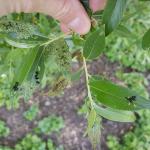
 Imported Willow Leaf Beetle: Plagiodera versicolora adult beetles overwinter near susceptible hosts. A few adult imported willow leaf beetles were seen feeding on willow foliage in Chesterfield, MA on 5/11/19 and no mating or egg laying was seen at the time.By 5/22/19, it was very easy to spot adult imported willow leaf beetles feeding and mating, as well as the damage they cause to the leaves. Egg laying was also observed on 5/22/19. On 5/29/19, feeding adult beetles and clusters of eggs were still observed. No larvae were yet seen at this particular location at that time. However, by 6/2/19, clusters of eggs hatched and tiny, feeding imported willow leaf beetle larvae could be seen. These yellow-ish larvae skeletonize the leaf in groups. Larvae were observed feeding on Japanese pussy willow and corkscrew willow on 6/12/19 in Boylston, MA. Extensive skeletonization of leaves was occurring on the corkscrew willow, in particular, at this location. See Regional Reports above for further updates. Larvae are slug-like and bluish-green to yellow in color. They will feed in clusters and skeletonize the leaves. Most plants can tolerate the feeding from this insect, and foliage will appear brown. Repeated yearly feeding can be an issue, in which case management of the young larvae may be necessary. Take care with treatment in areas near water.
Imported Willow Leaf Beetle: Plagiodera versicolora adult beetles overwinter near susceptible hosts. A few adult imported willow leaf beetles were seen feeding on willow foliage in Chesterfield, MA on 5/11/19 and no mating or egg laying was seen at the time.By 5/22/19, it was very easy to spot adult imported willow leaf beetles feeding and mating, as well as the damage they cause to the leaves. Egg laying was also observed on 5/22/19. On 5/29/19, feeding adult beetles and clusters of eggs were still observed. No larvae were yet seen at this particular location at that time. However, by 6/2/19, clusters of eggs hatched and tiny, feeding imported willow leaf beetle larvae could be seen. These yellow-ish larvae skeletonize the leaf in groups. Larvae were observed feeding on Japanese pussy willow and corkscrew willow on 6/12/19 in Boylston, MA. Extensive skeletonization of leaves was occurring on the corkscrew willow, in particular, at this location. See Regional Reports above for further updates. Larvae are slug-like and bluish-green to yellow in color. They will feed in clusters and skeletonize the leaves. Most plants can tolerate the feeding from this insect, and foliage will appear brown. Repeated yearly feeding can be an issue, in which case management of the young larvae may be necessary. Take care with treatment in areas near water.- Lily Leaf Beetle: Lilioceris lilii adults overwintered in sheltered places. Although adult beetles were not seen during the chilly weather on 5/13/19 in Amherst, MA, previously laid eggs were found on host plant foliage in this location. As of 5/21/19, egg hatch had occurred and larvae of various sizes could be seen feeding on foliage in groups. Smaller larvae skeletonize leaves, whereas larger larvae can eat the entire leaf. By 5/30/19, large lily leaf beetle larvae were observed eating entire leaves. Conditions were also favorable to see adults mating, and eggs could also still be found at this location on 5/30. On 6/3/19, adult lily leaf beetles, eggs, and larvae of various sizes were still seen on host plants. Susceptible hosts include Lilium spp. (Turk’s cap, tiger, Easter, Asiatic, and Oriental lilies) and Fritillaria spp. (Note: daylilies are not hosts.) Typically, in May, mating will occur and each female will begin to lay 250-450 eggs in neat rows on the underside of the foliage. If there are only a few plants in the garden, hand picking and destroying overwintering adults can help reduce local garden-level populations.
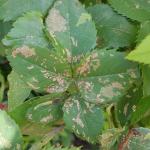
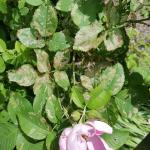
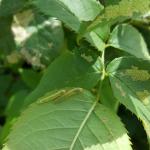 Roseslugs: Although two species of sawfly are typically termed “roseslugs”, one in particular, Endelomyia aethiops, may be problematic on Rosa spp. in Massachusetts at this time. Larval roseslug sawflies were seen skeletonizing the upper leaf surfaces of Rosa spp. at a location in Boylston, MA on 6/12/19. These insects are native to the Northeast. The adult female sawfly inserts her eggs, one by one, into the edges of host plant leaves. These eggs hatch and the larvae feed through the end of June, skeletonizing upper leaf surfaces. Once the caterpillars are fully grown (approximately ½ inch in length), they drop to the ground to construct overwintering cells. Pupation occurs the following spring and adults emerge shortly thereafter. There is one generation per year. Btk will not manage sawflies, as they are members of the Hymenoptera, not the Lepidoptera.
Roseslugs: Although two species of sawfly are typically termed “roseslugs”, one in particular, Endelomyia aethiops, may be problematic on Rosa spp. in Massachusetts at this time. Larval roseslug sawflies were seen skeletonizing the upper leaf surfaces of Rosa spp. at a location in Boylston, MA on 6/12/19. These insects are native to the Northeast. The adult female sawfly inserts her eggs, one by one, into the edges of host plant leaves. These eggs hatch and the larvae feed through the end of June, skeletonizing upper leaf surfaces. Once the caterpillars are fully grown (approximately ½ inch in length), they drop to the ground to construct overwintering cells. Pupation occurs the following spring and adults emerge shortly thereafter. There is one generation per year. Btk will not manage sawflies, as they are members of the Hymenoptera, not the Lepidoptera.- Spotted Lanternfly: (Lycorma delicatula, SLF) is not known to occur in Massachusetts landscapes (no established populations are known in MA at this time). However, officials with the Massachusetts Department of Agricultural Resources (MDAR) urged residents to check plants for spotted lanternfly. On February 21, 2019 MDAR announced the discovery of a single dead spotted lanternfly adult at a private residence in Boston. As a result of this discovery, officials asked the public to check potted plants they purchase and report any suspicious insects. MDAR reports that this particular individual appeared to have been unintentionally transported this past December in a shipment of poinsettia plants originating from Pennsylvania. Officials also report that there is currently no evidence that this pest has become established in MA. For more information about this finding, please visit the MA Department of Agricultural Resources press release:https://www.mass.gov/news/state-agricultural-officials-urge-residents-to-check-plants-for-spotted-lanternfly .
This insect is a member of the Order Hemiptera (true bugs, cicadas, hoppers, aphids, and others) and the Family Fulgoridae, also known as planthoppers. The spotted lanternfly is a non-native species first detected in the United States in Berks County, Pennsylvania and confirmed on September 22, 2014.
The spotted lanternfly is considered native to China, India, and Vietnam. It has been introduced as a non-native insect to South Korea and Japan, prior to its detection in the United States. In South Korea, it is considered invasive and a pest of grapes and peaches. The spotted lanternfly has been reported from over 70 species of plants, including the following: tree of heaven (Ailanthus altissima) (preferred host), apple (Malus spp.), plum, cherry, peach, apricot (Prunus spp.), grape (Vitis spp.), pine (Pinus spp.), pignut hickory (Carya glabra), sassafras (Sassafras albidum), serviceberry (Amelanchier spp.), slippery elm (Ulmus rubra), tulip poplar (Liriodendron tulipifera), white ash (Fraxinus americana), willow (Salix spp.), American beech (Fagus grandifolia), American linden (Tilia americana), American sycamore (Platanus occidentalis), big-toothed aspen (Populus grandidentata), black birch (Betula lenta), black cherry (Prunus serotina), black gum (Nyssa sylvatica), black walnut (Juglans nigra), dogwood (Cornus spp.), Japanese snowbell (Styrax japonicus), maple (Acer spp.), oak (Quercus spp.), and paper birch (Betula papyrifera).
The adults and immatures of this species damage host plants by feeding on sap from stems, leaves, and the trunks of trees. In the springtime in Pennsylvania (late April - mid-May) nymphs (immatures) are found on smaller plants and vines and new growth of trees and shrubs. Third and fourth instar nymphs migrate to the tree of heaven and are observed feeding on trunks and branches. Trees may be found with sap weeping from the wounds caused by the insect’s feeding. The sugary secretions (excrement) created by this insect may coat the host plant, later leading to the growth of sooty mold. Insects such as wasps, hornets, bees, and ants may also be attracted to the sugary waste created by the lanternflies, or sap weeping from open wounds in the host plant. Host plants have been described as giving off a fermented odor when this insect is present.
Adults are present by the middle of July in Pennsylvania and begin laying eggs by late September and continue laying eggs through late November and even early December in that state. Adults may be found on the trunks of trees such as the tree of heaven or other host plants growing in close proximity to them. Egg masses of this insect are gray in color and, in some ways, look similar to gypsy moth egg masses.
Host plants, bricks, stone, lawn furniture, recreational vehicles, and other smooth surfaces can be inspected for egg masses. Egg masses laid on outdoor residential items such as those listed above may pose the greatest threat for spreading this insect via human aided movement.
For more information about the spotted lanternfly, visit this fact sheet: https://ag.umass.edu/landscape/fact-sheets/spotted-lanternfly .
- Taxus Mealybug: Dysmicoccus wistariae was spotted on Taxus in Amherst on 5/30/19 and again on 6/3/19. This insect will produce honeydew and lead to sooty mold growth, yellowing of needles, and sparsely foliated plants. Eventual dieback may be possible. This species is commonly associated with Taxus in New England, but can be occasionally found on dogwood, Rhododendron, Prunus spp., maple, Andromeda, and crabapple. These mealybugs are found on stems and branches and particularly like to congregate at branch crotches. Management may be targeted between 246-618 GDD’s. Horticultural oil and neem oil may be used according to label instructions.
- Viburnum Leaf Beetle: Pyrrhalta viburni is a beetle in the family Chrysomelidae that is native to Europe, but was found in Massachusetts in 2004. See Regional Reports above for updates regarding the activity of this pest. In Amherst, MA on 5/29/19 and again on 6/4/19, Viburnum leaf beetle larvae were observed causing significant feeding damage on Viburnum. The population appears high enough to cause complete defoliation of the shrubs in this location. This beetle feeds exclusively on many different species of Viburnum, which includes, but is not limited to, susceptible plants such as V. dentatum, V. nudum, V. opulus, V. propinquum, and V. rafinesquianum. Larvae may be treated with a product containing spinosad. Some Viburnum have been observed to have varying levels of resistance to this insect, including but not limited to V. bodnantense, V. carlesii, V. davidii, V. plicatum, V. rhytidophyllum, V. setigerum, and V. sieboldii. More information about Viburnum leaf beetle may be found at http://www.hort.cornell.edu/vlb/ .
- White Spotted Pine Sawyer (WSPS): Monochamus scutellatus adults can emerge now throughout July, depending on local temperatures. This is a native insect in Massachusetts and is usually not a pest. Larvae develop in weakened or recently dead conifers, particularly eastern white pine (Pinus strobus). However, the white spotted pine sawyer looks very similar to the invasive Asian Longhorned Beetle, Anoplophora glabripennis, ALB. ALB adults do not emerge in Massachusetts until July and August. Beginning in July, look for the key difference between WSPS and ALB adults, which is a white spot in the top center of the wing covers (the scutellum) on the back of the beetle. White spotted pine sawyer will have this white spot, whereas Asian longhorned beetle will not. Both insects can have other white spots on the rest of their wing covers; however, the difference in the color of the scutellum is a key characteristic. See the Asian longhorned beetle entry above for more information about that non-native insect.
- Woolly Apple Aphid: Eriosoma lanigerum may be found on apple, crabapple, hawthorn, mountain-ash, Pyracantha, and elm hosts. The primary (winter) host is elm, on which aphids infest emerging spring leaves, causing leaves to curl or close into stunted, rosette-like clusters found at twig tips. Woolly apple aphid was observed on elm on 6/3/2019 in Amherst, MA. Rosettes at this location are full of honeydew producing aphids. On apple and crabapple, this species of aphid colonizes roots, trunks, and branches in the summer and is commonly found near previous wounds or callous tissue. On roots, the aphids cause swelled areas which can girdle and kill roots. The aphids, when found in above ground plant parts such as elm leaves, are covered with white wax. Eggs are the overwintering stage on elm, which hatch in the spring in time for the nymphs to infest new elm foliage. Following a few generations on elm, the aphids will develop into a winged form, which will disperse and seek out apple and crabapple. Multiple generations will occur on these alternate hosts in the summer and by the fall, a winged form will return to elm and mated females will lay eggs near elm buds.
- Woolly Elm Aphid: Eriosoma americanum females lay a single egg in the cracks and crevices of elm bark, where the egg overwinters. Eggs hatch on elm in the spring as leaves are unfolding. A young, wingless female hatched from the egg feeds on the underside of leaf tissue. This female aphid matures and gives birth to 200 young, all females, without mating. These aphids feed, and the elm leaf curls around them and protects them. Curled leaves, due to the activity of the woolly elm aphid, were observed in Amherst, MA on 5/30/19. Opening these curled leaves revealed ample numbers of honeydew producing aphids within. By the end of June, winged migrants mature and find serviceberry hosts. Another set of females is produced. These new females crawl to and begin feeding on the roots of serviceberry. Multiple generations occur on the roots of serviceberry through the summer.
Concerned that you may have found an invasive insect or suspicious damage caused by one? Need to report a pest sighting? If so, please visit the Massachusetts Introduced Pests Outreach Project: http://massnrc.org/pests/pestreports.htm .
A note about Tick Awareness: deer ticks (Ixodes scapularis), the American dog tick (Dermacentor variabilis), and the lone star tick (Amblyomma americanum) are all found throughout Massachusetts. Each can carry their own complement of diseases. Anyone working in tick habitats (wood-line areas, forested areas, and landscaped areas with ground cover) should check themselves regularly for ticks while practicing preventative measures. Have a tick and need it tested? Visit the web page of the UMass Laboratory of Medical Zoology (https://www.tickreport.com/ ) and click on the blue Order a TickReport button for more information.
Reported by Tawny Simisky, Extension Entomologist, UMass Extension Landscape, Nursery, & Urban Forestry Program
Additional Resources
To receive immediate notification when the next Landscape Message update is posted, be sure to join our e-mail list and follow us on Facebook and Twitter.
For a complete listing of upcoming events, see our Upcoming Educational Events page.
For commercial growers of greenhouse crops and flowers - Check out UMass Extension's Greenhouse Update website
For professional turf managers - Check out Turf Management Updates
For home gardeners and garden retailers - Check out home lawn and garden resources. UMass Extension also has a Twitter feed that provides timely, daily gardening tips, sunrise and sunset times to home gardeners, see https://twitter.com/UMassGardenClip
Diagnostic Services
A UMass Laboratory Diagnoses Landscape and Turf Problems - The UMass Extension Plant Diagnostic Lab is available to serve commercial landscape contractors, turf managers, arborists, nurseries and other green industry professionals. It provides woody plant and turf disease analysis, woody plant and turf insect identification, turfgrass identification, weed identification, and offers a report of pest management strategies that are research based, economically sound and environmentally appropriate for the situation. Accurate diagnosis for a turf or landscape problem can often eliminate or reduce the need for pesticide use. For sampling procedures, detailed submission instructions and a list of fees, see Plant Diagnostics Laboratory
Soil and Plant Nutrient Testing - The University of Massachusetts Soil and Plant Nutrient Testing Laboratory is located on the campus of The University of Massachusetts at Amherst. Testing services are available to all. The function of the Soil and Plant Nutrient Testing Laboratory is to provide test results and recommendations that lead to the wise and economical use of soils and soil amendments. For complete information, visit the UMass Soil and Plant Nutrient Testing Laboratory web site. Alternatively, call the lab at (413) 545-2311.
Ticks are active at this time! Remember to take appropriate precautions when working and playing outdoors, and conduct daily tick checks. UMass tests ticks for the presence of Lyme disease and other disease pathogens. Learn more.
